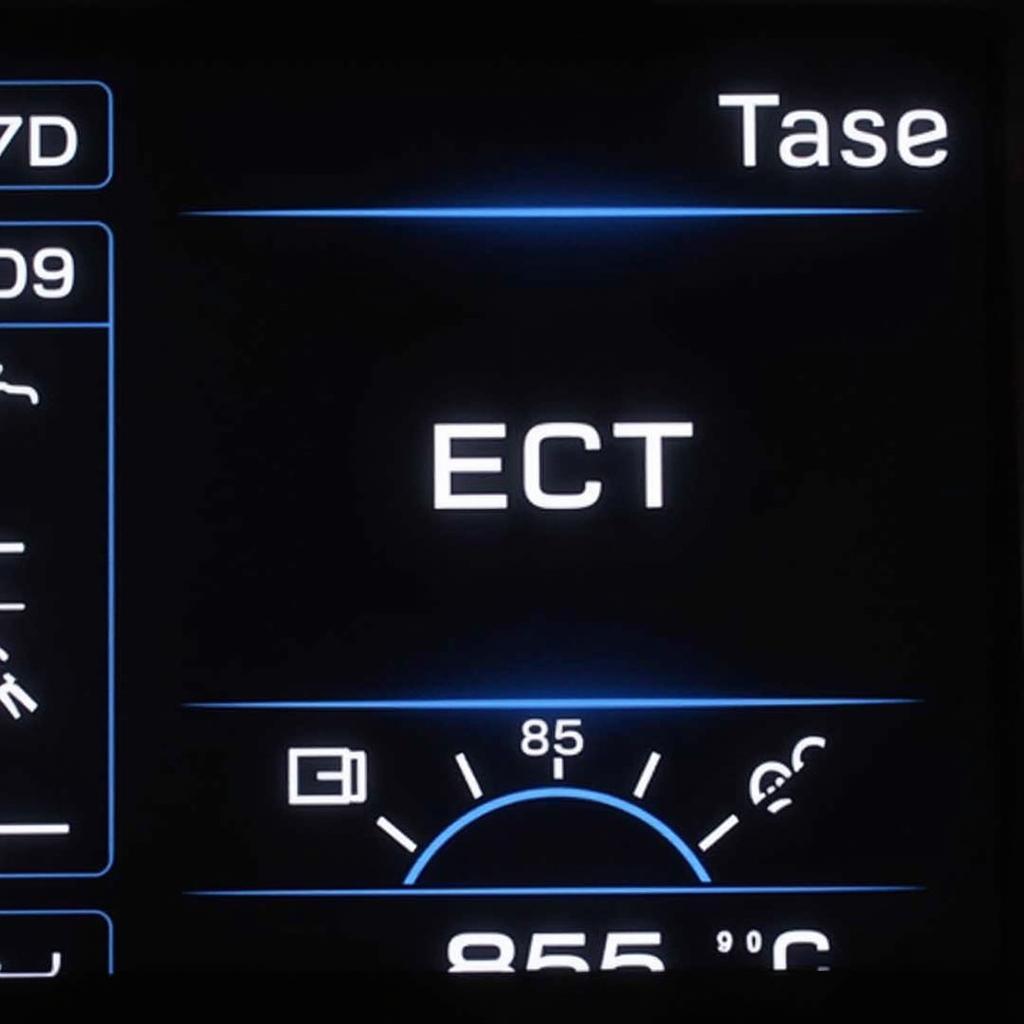Knowing how to check the ECT sensor with a scan tool is essential for diagnosing engine performance issues. The Engine Coolant Temperature (ECT) sensor plays a vital role in your vehicle’s engine management system. It provides real-time data to the Engine Control Unit (ECU), influencing crucial factors like fuel injection timing, ignition timing, and emissions control.
Understanding the ECT Sensor and Its Importance
The ECT sensor is a small, usually two-wire, sensor located near the thermostat housing or in the coolant flow path. It works on the principle of resistance change with temperature variations. As the engine heats up, the sensor’s resistance decreases, signaling the ECU to adjust various engine parameters for optimal performance and fuel efficiency.
Common Symptoms of a Faulty ECT Sensor
A malfunctioning ECT sensor can send inaccurate data to the ECU, leading to several issues, including:
- Difficult starting, especially in cold weather: The ECU may not provide the correct fuel-air mixture for a cold start if the ECT sensor delivers faulty readings.
- Poor fuel economy: Inaccurate temperature readings can cause the ECU to run the engine rich (too much fuel) or lean (too little fuel), impacting fuel efficiency.
- Engine overheating: A faulty sensor might not alert the ECU about rising temperatures, increasing the risk of overheating.
- Check Engine Light illumination: The ECU triggers the Check Engine Light to indicate a problem with the ECT circuit.
Using a Scan Tool to Check Your ECT Sensor
Using a scan tool is a simple yet effective way to diagnose a potentially faulty ECT sensor. Here’s how:
- Locate the OBD-II port: The OBD-II port is usually located under the dashboard on the driver’s side.
- Connect the scan tool: Plug the scan tool into the OBD-II port.
- Turn the ignition ON: Turn the ignition key to the ON position without starting the engine.
- Access Live Data: Navigate to the “Live Data” or “Data Stream” section on your scan tool.
- Locate ECT Sensor Reading: Find the parameter labeled “ECT” or “Engine Coolant Temperature.”
 Scan tool displaying ECT sensor reading
Scan tool displaying ECT sensor reading
Interpreting the Scan Tool Readings
- Compare the ECT reading with the dashboard gauge: The scan tool’s ECT value should closely match the temperature reading on your vehicle’s dashboard gauge. A significant discrepancy suggests a potential issue with the sensor.
- Monitor the ECT value during warm-up: As the engine warms up, the ECT value should rise steadily and stabilize at the normal operating temperature (typically between 195°F to 220°F).
- Check for erratic readings: Fluctuating or inconsistent ECT values while the engine is running can indicate a failing sensor.
Beyond the Basics: Advanced Diagnostics with a Scan Tool
While the above steps can help identify a potentially faulty ECT sensor, a scan tool can be utilized for a more in-depth diagnosis.
- Compare ECT readings with other sensors: Cross-referencing the ECT readings with other sensor data, such as the Intake Air Temperature (IAT) sensor, can provide further insight into potential inconsistencies.
- Perform active tests: Some advanced scan tools offer active test functions that allow you to command the ECT sensor to specific values and observe the response, helping pinpoint faulty wiring or sensor issues.
When to Seek Professional Help
While checking the ECT sensor with a scan tool can provide valuable information, remember that a proper diagnosis might require specialized equipment and expertise. If you’re uncomfortable interpreting the data or suspect a more complex issue, it’s always best to consult a qualified mechanic.
Conclusion
Knowing how to check the ECT sensor with a scan tool is a valuable skill for any car enthusiast. It empowers you to diagnose potential engine issues related to temperature readings. Remember, a properly functioning ECT sensor ensures optimal engine performance, fuel efficiency, and ultimately, a smoother, more enjoyable driving experience.
FAQs
Q1: Can I drive with a bad ECT sensor?
While you might be able to drive short distances with a malfunctioning ECT sensor, it’s not recommended. Driving with a bad sensor can lead to decreased fuel economy, reduced engine performance, and potentially cause further damage to your engine.
Q2: How much does it cost to replace an ECT sensor?
The cost of replacing an ECT sensor can vary depending on your vehicle’s make and model and labor costs in your area. On average, you can expect to pay between $50 to $200 for the sensor itself and another $50 to $150 for labor.
Q3: How often should the ECT sensor be replaced?
The ECT sensor doesn’t have a specific replacement interval. It’s generally recommended to inspect and test the sensor if you experience symptoms of a malfunctioning sensor or during other engine-related repairs.
Do you want to explore other ways a scan tool can help you diagnose car problems? Read our articles on how to check fuel injectors with scan tool and hyundai tpms scan tool. For those looking for specific car model applications, check our piece on 2001 vw passat scan tool.
Need further assistance? Our dedicated team is here to help! Contact us via WhatsApp: +1(641)206-8880, Email: [email protected] or visit us at 276 Reock St, City of Orange, NJ 07050, United States. We provide 24/7 customer support for all your car diagnostic needs.


